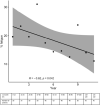Long-term fatigue following aneurysmal subarachnoid haemorrhage and the impact on employment
- PMID: 36039524
- PMCID: PMC9825863
- DOI: 10.1111/ene.15533
Long-term fatigue following aneurysmal subarachnoid haemorrhage and the impact on employment
Abstract
Background and purpose: Fatigue is common following aneurysmal subarachnoid haemorrhage (aSAH) but little is known about its frequency, prognosis and impact on employment. The aim of this study was to assess the frequency of fatigue, whether it changes over time and the relationship to employment in the long term.
Methods: This was a retrospective observational study of aSAH cases and matched controls from the UK Biobank. The presence of fatigue was compared between cases and controls using the chi-squared test. The change in frequency over time was assessed using Spearman's rank correlation coefficient. The effect of fatigue on employment was assessed using mediation analysis.
Results: Fatigue is more common following aSAH compared to matched controls (aSAH 18.7%; controls 13.7%; χ2 = 13.0, p < 0.001) at a mean follow-up of 123 months. Fatigue gradually improves over time with significant fatigue decreasing by 50% from ~20% in the first year to ~10% after a decade (p = 0.04). Fatigue significantly mediated 24.0% of the effect of aSAH status on employment.
Conclusions: Fatigue is common following aSAH and persists in the long term. It gradually improves over time but has a major impact on aSAH survivors, significantly contributing to unemployment following haemorrhage. Further work is required to develop treatments and management strategies for fatigue with a view to improving this symptom and consequently employment following aSAH.
Keywords: employment; fatigue; outcome; subarachnoid haemorrhage.
© 2022 The Authors. European Journal of Neurology published by John Wiley & Sons Ltd on behalf of European Academy of Neurology.
Conflict of interest statement
None.
Figures
References
-
- Taylor TN, Davis PH, Torner JC, Holmes J, Meyer JW, Jacobson MF. Lifetime cost of stroke in the United States. Stroke. 1996;27(9):1459‐1466. - PubMed
-
- Gaastra B, Ewbank F, Tapper W, Bulters D, Galea I. Long‐term cognitive outcome following aneurysmal subarachnoid haemorrhage. J Stroke Cerebrovasc Dis. 2022;31(1):106184. - PubMed
-
- Visser‐Meily JM, Rhebergen ML, Rinkel GJ, van Zandvoort MJ, Post MW. Long‐term health‐related quality of life after aneurysmal subarachnoid hemorrhage: relationship with psychological symptoms and personality characteristics. Stroke. 2009;40(4):1526‐1529. - PubMed
-
- Gaastra B, Ashokumar M, Bulters D, Campbell N, Galea I. Auditory outcome following aneurysmal subarachnoid haemorrhage. J Neurol Sci. 2021;434:120125. - PubMed
Publication types
MeSH terms
Grants and funding
LinkOut - more resources
Full Text Sources



